Hey there! Get ready to fall in love with Madrid, Spain’s buzzing capital that’s sure to give you a travel experience like no other. Brimming with a rich culture, tons of historic spots, unbeatable museums, colorful neighborhoods, and food that’ll make you drool, Madrid has got a little something for all you travelers out there.
In this super-detailed guide, we’re gonna arm you with all the must-know deets to get the best out of your Madrid adventure. Doesn’t matter if you’re roaming around the top tourist spots, sampling the killer local grub, or just soaking up the city’s pulsating culture, Madrid’s going to stick in your memory for sure. So, without further ado, let’s kick off this journey and see what makes Madrid so awesome!
Key Takeaways:
- Madrid is a vibrant capital city with a rich cultural heritage and numerous attractions.
- The city offers a diverse range of activities, from exploring historical landmarks to indulging in delicious cuisine.
- Madrid’s top attractions include the Royal Palace, Plaza Mayor, and world-class museums like the Prado and Reina Sofia.
- When visiting Madrid, make sure to explore the different neighborhoods, such as La Latina and Malasaña.
- Don’t miss out on experiencing Madrid’s lively nightlife and exploring the city’s green oases, like El Retiro Park.
Why Madrid Should Be Your Next Destination
Madrid, the vibrant capital of Spain, is a city that should be at the top of your travel bucket list. With its incredible attractions and unique experiences, Madrid offers something for everyone. Whether you are interested in exploring iconic landmarks, immersing yourself in the city’s rich cultural offerings, or indulging in delicious cuisine, Madrid will captivate your senses and leave you with memories to last a lifetime.
One of the top attractions in Madrid is the Royal Palace, an iconic landmark that showcases stunning architecture, beautiful gardens, and opulent interiors. As the official residence of the Spanish royal family, the Royal Palace offers visitors a glimpse into the city’s regal past. Another must-visit is Plaza Mayor, a historic square in the heart of Madrid. With its grand architecture and lively atmosphere, Plaza Mayor is a vibrant hub that reflects the city’s rich history.
When it comes to culture, Madrid is unparalleled. The city is home to world-class museums such as the Prado Museum, which houses a vast collection of European masterpieces, and the Reina Sofia Museum, dedicated to modern and contemporary art. Madrid’s cultural scene also extends to its theaters, music, and dance performances, ensuring that visitors can immerse themselves in the city’s artistic offerings.
To fully experience Madrid, exploring its diverse neighborhoods is a must. Each neighborhood has its unique charm and character. For example, La Latina is known for its traditional tapas bars, vibrant street markets, and cultural heritage, while Malasaña is Madrid’s hipster heartland, filled with trendy shops, alternative music venues, and eclectic street art.
When it comes to food, Madrid is a culinary paradise. From traditional Spanish dishes like paella and tapas to innovative fusion cuisine, the city’s food scene caters to all tastes. Exploring local markets and trying authentic Spanish delicacies is a must for food enthusiasts.
With its myriad of attractions, vibrant culture, and warm hospitality, Madrid is a destination that will leave you longing to return. Whether you are a history buff, art lover, foodie, or simply seeking to immerse yourself in the lively atmosphere of a thriving metropolis, Madrid will exceed your expectations. So pack your bags and get ready to embark on an unforgettable adventure in the heart of Spain!
Planning Your Madrid Adventure
Welcome to Madrid, the vibrant capital of Spain! As you embark on your travel journey to this enchanting city, it’s essential to plan your trip wisely to make the most of your time. In this section, we will guide you through the key aspects of planning your Madrid adventure, including the best time to visit, finding the perfect accommodation, and navigating the city’s transportation system.
Madrid is full of historical sites, museums, parks, and local markets. Make sure to include top attractions like the Prado Museum, Royal Palace, and Retiro Park in your itinerary. Also, don’t miss the chance to try local foods in San Miguel Market or any traditional Madrid restaurants.
Although English is spoken in many tourist areas, it’s advantageous to learn some basic Spanish phrases.

Remember to plan your trip to Madrid with the understanding that every traveler’s experience is unique. Take these tips as guidelines to tailor your trip to best suit your interests and preferences. Happy Travels!
Best Time to Visit
Madrid experiences a Mediterranean climate, characterized by hot summers and mild winters. The ideal time to visit the city is during the spring (April to June) and fall (September to November) seasons. During these months, the weather is pleasant, with temperatures ranging from 60°F (15°C) to 75°F (24°C). Exploring Madrid’s top attractions and strolling through its beautiful parks and gardens are best enjoyed in this comfortable weather.
Additionally, spring and fall bring a festive atmosphere to Madrid, with various events and festivals taking place. From the famous San Isidro Festival in May to the Autumn Festival in October, you’ll have the opportunity to immerse yourself in the local culture and experience the vibrant spirit of the city.
It’s advisable to avoid visiting Madrid during the peak summer months of July and August when temperatures can soar above 90°F (32°C). These months tend to be hot and crowded, as many locals take their summer vacations during this time. To ensure a more enjoyable experience, plan your visit during the shoulder seasons for a perfect blend of good weather and fewer crowds.
Finding the Perfect Accommodation
Madrid offers a wide range of accommodation options to suit every traveler’s needs and preferences. Whether you’re looking for luxury hotels, budget-friendly hostels, or cozy apartments, you’ll find plenty of choices to consider.
Here are some tips to help you find the perfect place to stay in Madrid:
- Research popular neighborhoods: Madrid boasts diverse neighborhoods, each with its unique character and attractions. Consider your preferences and interests, whether you prefer a central location, a lively atmosphere, or a more residential area.
- Read reviews and ratings: Before making a booking, take the time to read reviews from previous guests. Websites like TripAdvisor and Booking.com provide valuable insights into the quality and experiences of various accommodations.
- Book in advance: Madrid is a popular tourist destination, especially during peak seasons. To secure your preferred accommodation, it’s recommended to book in advance and avoid last-minute stress.
- Consider apartment rentals: Renting an apartment can be a great option if you prefer a more home-like experience. It gives you the flexibility to cook your meals and enjoy the comfort of a private space.
By following these tips, you’ll be able to find the perfect accommodation that fits your budget, location preferences, and travel style.
Navigating the City: Transport Tips
Madrid has an efficient and extensive transportation system that makes exploring the city and its surroundings convenient and accessible.
Here are some essential tips for navigating Madrid’s transportation network:
- Metro: The Madrid Metro is the fastest and most popular way around the city. With a vast network of lines and stations, it provides easy access to major tourist attractions and neighborhoods.
- Buses: Madrid’s bus network is another convenient option for traveling within the city. Buses cover a wider area than the metro, making them an excellent choice for reaching destinations that are not served by the subway.
- Trains: If you plan to venture beyond the city limits, Madrid’s train system offers excellent connections to other cities in Spain. The Alta Velocidad Española (AVE) high-speed train network is particularly convenient for day trips to nearby destinations.
- Transportation passes: To save money and simplify your travel, consider purchasing a transportation pass. The Madrid Tourist Travel Pass offers unlimited access to the metro, buses, and trains within Madrid’s metropolitan area for a specified number of days.
Whether you’re visiting famous attractions or exploring off-the-beaten-path neighborhoods, Madrid’s transportation system will make your journey smooth and efficient.
Now that you have a solid plan in place, it’s time to embark on your Madrid adventure. The city awaits you, ready to charm you with its captivating history, vibrant culture, and unforgettable experiences!
The Heart of Madrid: Must-Visit Historical Landmarks
When exploring Madrid, immersing yourself in the city’s rich history is a must. Madrid is home to several remarkable historical landmarks that offer insight into the city’s past. Two of the top landmarks that should be on every traveler’s itinerary are the Royal Palace and Plaza Mayor.
The Royal Palace: A Regal Experience
The Royal Palace is an iconic symbol of Madrid and a testament to its grandeur. As the official residence of the Spanish royal family, this magnificent palace showcases stunning architecture, extravagant interiors, and beautiful gardens. A visit to the Royal Palace allows you to step into the world of royalty and experience the opulence of the past.
The Royal Palace, also known as Palacio Real, is the largest royal palace in Western Europe in terms of floor area. It was built in the 18th century by Felipe V on the site of a burned-out royal alcazar, a type of Moorish fortress. The palace, designed in a Baroque-Classicist style, is adorned with a characteristic blue-grey Spanish sky and has a total of 3,418 rooms.
A tour of the Royal Palace gives you a look into the royal chambers and the lavishly designed official reception rooms, the throne room, the Mirror Room, and the banquet hall, each exuding a charm of its own. Filled with art and historical artifacts, the interior is a treasure trove of painted frescoes, porcelain, watches, furniture, and silverware. It is a true reflection of the wealth and power of the Spanish monarchy over the past centuries.
The palace grounds too are worth exploring. The Plaza de Oriente, the grand square that faces the Royal Palace, is lined with statues of Spanish monarchs, while the Campo Del Moro, Sabatini Gardens, and Royal Botanical Garden add an element of tranquility and natural beauty to the grandeur of the Palace.
While the palace is formally the royal residence, it is only used for state ceremonies, while the reigning King Felipe VI and his family reside in the far more modest Zarzuela Palace on the outskirts of Madrid.
Plan your visit to the Royal Palace and get a chance to explore the royal history of Spain. Whether a history enthusiast, architecture lover, or merely a tourist, the Royal Palace offers a glimpse into the regal past of Spain that will leave you mesmerized.
Plaza Mayor: A Plaza with a Past
Located in the heart of Madrid, Plaza Mayor is a historic square that has witnessed significant events throughout the city’s history. With its grand architecture, bustling atmosphere, and surrounding cafes and restaurants, Plaza Mayor offers a glimpse into the vibrant past of Madrid. Take a stroll through the square, soak in the ambiance, and imagine the stories that unfolded within its walls.
Dating back to the 17th century, Plaza Mayor was initially known as “Plaza del Arrabal,” located just outside the city walls and serving as the primary marketplace for Madrid’s residents. King Felipe II, in his vision to make Madrid a central hub for political and economic activities, gave the task of designing this grand structure to architect Juan de Herrera. However, it was only accomplished under the reign of King Felipe III by the architect Juan Gómez de Mora.
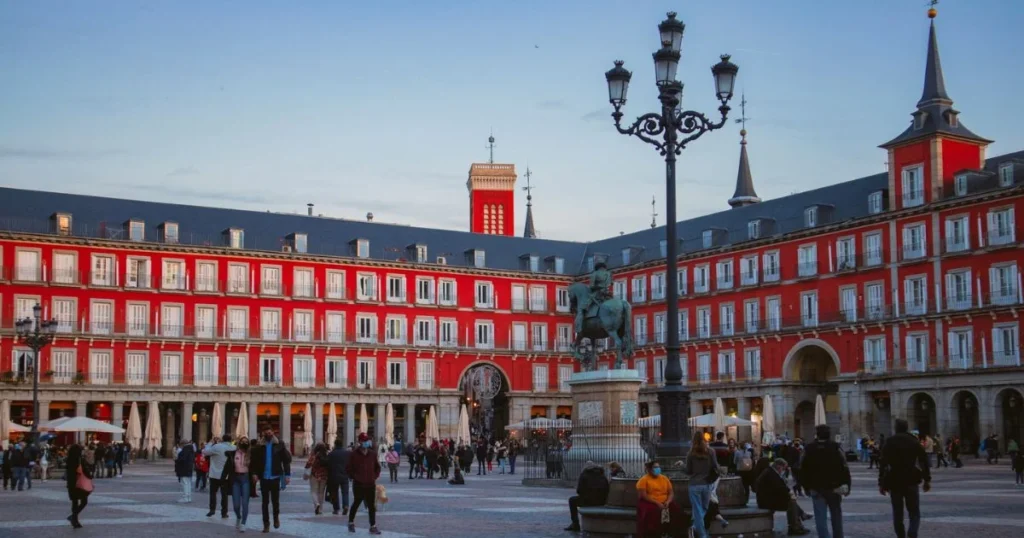
The grandiose square measures 129 m x 94 m (423 ft x 308 ft) and is adorned with symmetrical paseos (promenades), interconnected by nine entrances. Its most prominent architectural highlight is the stunning Casa de la Panadería, a four-story building that now houses the Madrid Tourist Information Center. With its diverse array of frescoes depicting mythological figures, the Casa de la Panadería is a masterpiece of the Madrid school of painting.
Plaza Mayor has been a silent bystander to many historic events – from bullfights to public executions, from royal coronations to fiestas and festivals. It was the beating heart of Madrid’s social life during the Habsburg period and has continued to be a popular gathering spot throughout the years.
Today, it retains its charm and appeal for both locals and tourists. Stop by the many cafes and restaurants lining the square and relish a traditional calamari sandwich or a warm cup of café con leche. Every Sunday, the square turns into a lively stamp and coin market, drawing crowds of collectors who stroll around to bargain and swap.
Additionally, there are numerous shops selling mementos of Madrid – from flamenco dresses to football jerseys – ensuring that visitors can take away a piece of Madrid with them.
A visit to Plaza Mayor is a journey in time, from Madrid’s medieval past to its vibrant present. With its rich heritage, magnificent architecture, and captivating atmosphere, Plaza Mayor indeed mirrors the spirit of Madrid.
Madrid Spain: A Journey Through Capital’s Culture
Madrid, the vibrant capital of Spain, is a city steeped in culture and artistic expression. Immerse yourself in the rich heritage of Madrid as you embark on a journey through its captivating cultural scene. From world-class theaters to awe-inspiring music performances, and graceful dance shows to traditional festivals, Madrid offers an array of cultural attractions that will leave you spellbound.
One of the highlights of Madrid’s cultural landscape is the Teatro Real, the city’s renowned opera house. Step into this architectural masterpiece and witness breathtaking performances that will transport you to another world. The Circulo de Bellas Artes, a prestigious cultural center, is another must-visit destination. Explore its art exhibitions, film screenings, and cultural events that showcase the city’s creative spirit.

Madrid’s love for music is evident in its vibrant music scene. Whether you’re a fan of classical compositions or contemporary beats, Madrid has something for everyone. Attend a concert at the Auditorio Nacional de Música, a prestigious concert hall that hosts world-class performances. For a more intimate experience, discover the city’s jazz clubs and underground music venues that pulse with energy and creativity.
No visit to Madrid would be complete without experiencing its timeless dance form, flamenco. Dive into the passionate world of flamenco by attending a mesmerizing flamenco show at one of the city’s intimate tablaos. Feel the emotions, hear the echoes of the guitar, and witness the intricate footwork that brings this art form to life.
Celebrating its cultural heritage, Madrid hosts a multitude of traditional festivals throughout the year. From the colorful San Isidro Festival, honoring the city’s patron saint, to the vibrant La Paloma Festival, Madrid comes alive with music, dances, and parades. Join the locals in these festive celebrations to immerse yourself in the true essence of Madrid’s culture.
Dive into Madrid’s World-Class Museums
Madrid is a city renowned for its rich cultural heritage and world-class museums. Whether you’re a history buff, an art enthusiast, or simply curious about Madrid’s cultural offerings, the city’s museums are a must-visit. From classic masterpieces to modern and contemporary art, Madrid’s museums showcase a diverse range of artistic treasures that will captivate and inspire you. In this section, we will explore three of Madrid’s most iconic museums: The Prado, Reina Sofia, and Thyssen Museum.
The Prado: A Treasure Trove of Masterpieces
The Prado Museum is a true gem in the heart of Madrid, housing an extensive collection of European art. With works spanning from the 12th to the 19th century, the Prado is a treasure trove of masterpieces by renowned artists such as Goya, Velázquez, Bosch, and Rubens. The museum’s impressive collection offers visitors a unique opportunity to immerse themselves in the rich artistic history of Madrid and Europe.
When visiting the Prado, be sure to admire Goya’s masterpiece, “The Third of May 1808,” which portrays a powerful and poignant scene from the Spanish War of Independence. Additionally, don’t miss Velázquez’s iconic painting, “Las Meninas,” which is considered one of the greatest masterpieces in Western art history.
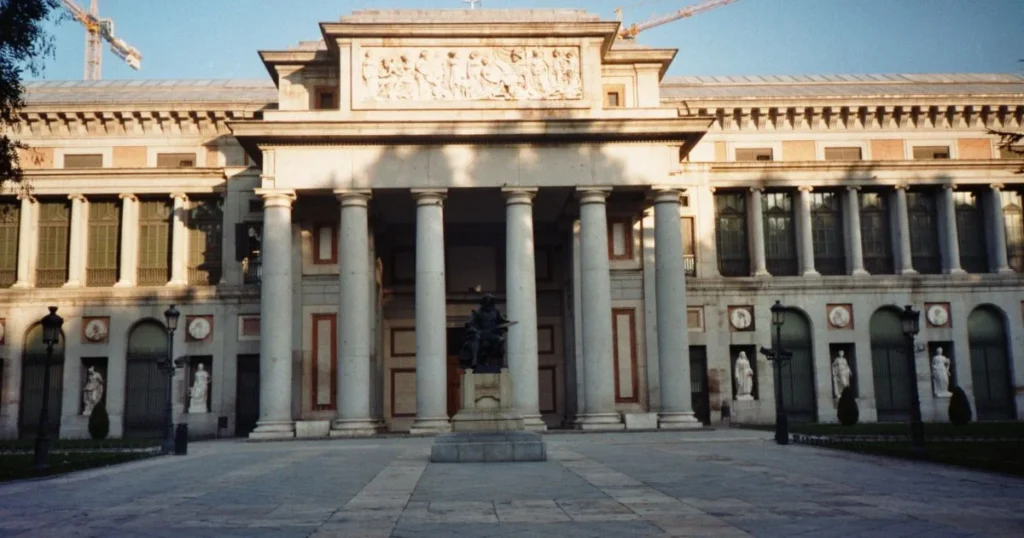
To make the most of your visit, consider joining a guided tour or audio guide to gain deeper insights into the artwork and its historical significance. Aside from the renowned masterpieces, the Prado Museum also has a vast collection of drawings, prints, and sculptures, as well as decorative arts and historical documents. As you explore the museum, you will come across other significant works including Rubens’ “The Three Graces” and Bosch’s “The Garden of Earthly Delights”.
These well-crafted pieces are truly breathtaking and will give you a glimpse into the skill and storytelling abilities of these profound artists. In addition to its permanent collection, the Prado also hosts rotating exhibits and special events, which often showcase particular periods, artists, or themes in art history. Be sure to check out the museum’s calendar to keep up with their latest offerings.
It is recommended to allot at least a few hours to tour the Prado as it is enormous, with over 7,000 paintings, 1,000 sculptures, and thousands of drawings and prints. There is so much to see, it’s nearly impossible to take in all in one visit. If needed, there are also places to eat within the museum, as well as a bookstore where you can purchase postcards and books about the works of art exhibited.
The Prado Museum is a must-visit institution for art aficionados and history buffs alike. Its formidable collection is bound to leave visitors inspired and in awe of the cultural wealth it contains. Whether it’s your first or fifth visit, each trip to the Prado offers a fresh perspective and a new appreciation for the timeless beauty and power of art.
Reina Sofia: Modern Art in the Making
The Reina Sofia Museum is a vibrant hub for modern and contemporary art in Madrid. It is home to a diverse collection that showcases the works of Spanish artists such as Pablo Picasso and Salvador Dalí. The museum’s centerpiece is Picasso’s famous masterpiece, “Guernica,” a powerful depiction of the suffering and devastation caused by war. This iconic painting has become a symbol of peace and a testament to the resilience of the human spirit.
Exploring the Reina Sofia Museum offers a unique opportunity to witness the evolution of art in the 20th and 21st centuries. From the avant-garde movements of Cubism and Surrealism to contemporary installations and video art, the museum presents a dynamic and thought-provoking journey through modern artistic expressions.

The museum was first opened to the public in 1992, initially created to house Spanish art of the 20th century.
However, the institution quickly evolved, and now features works from international artists, making it a global center for modern art. Its collection is divided into three main sections: the 1900-1945 Collection, the 1945-1968 Collection, and the 1968-1982 Collection. This chronological organization allows visitors to understand the influences and changes that have shaped the art world in the past century.
The Reina Sofia Museum also hosts temporary exhibitions, performances, workshops, and film screenings, embodying a multi-disciplinary approach that reflects the interconnectedness of different art forms in the contemporary era.
Apart from its powerful and evocative art, the museum itself is a work of architectural beauty. It is housed in the former San Carlos Hospital, an 18th-century building that seamlessly blends classic and modern elements after being redesigned by French architect Jean Nouvel.
With its sleek glass and steel extensions harmoniously integrated with the century-old structure, the museum campus is a visual feast in itself. The Reina Sofia Museum is not just a place to view art, but to experience it. It is a testament to the enduring and transformative power of creativity, a venue where visitors can immerse themselves in innovative artistic visions that continue to shape and challenge our understanding of the world.
It is a must-visit for art lovers visiting Madrid, offering an introspective journey into the minds of artists who dared to push the boundaries and redefine the possibilities of art.
Thyssen Museum: Where Art Meets History
The Thyssen Museum is a hidden gem nestled in Madrid’s Golden Triangle of Art. This unique museum offers a remarkable collection of art from various periods, making it a perfect blend of beauty, history, and culture. From Renaissance masterpieces to Impressionist and Expressionist works, the Thyssen Museum showcases a diverse range of artistic styles and movements.
When exploring the Thyssen Museum, admire Jan van Eyck’s exquisite “The Annunciation,” immerse yourself in the vibrant colors of Monet’s “Water Lilies,” and appreciate the emotional depth of Edward Hopper’s “Hotel Room.” The museum’s diverse collection ensures there is something for every art enthusiast to enjoy and appreciate.
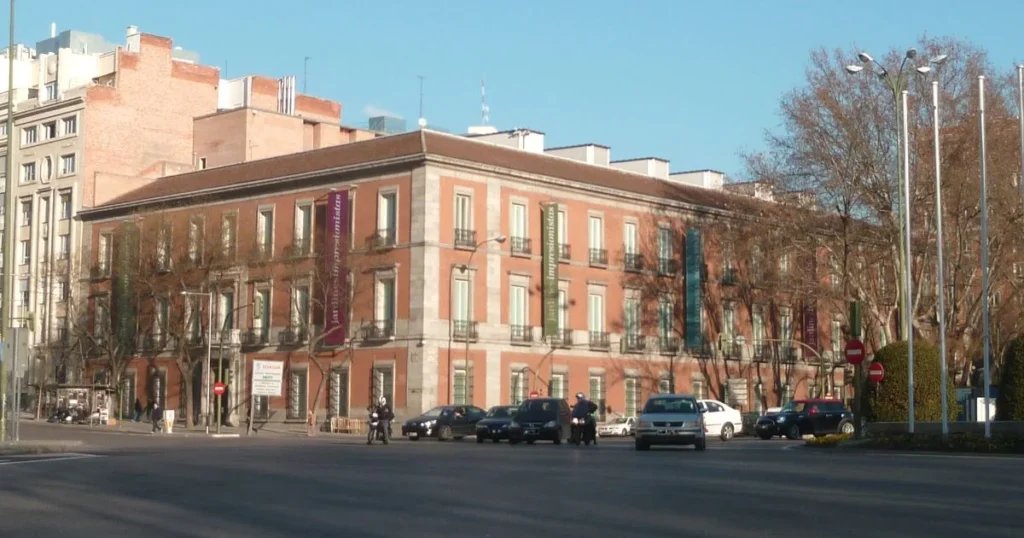
It’s easy to get lost in the collection’s variety and extensive timeline, which spans from the 13th century to the 20th century.
It includes a unique representation of the 19th and 20th-century American art collections, which distinguishes it from other European art museums. In addition to its impressive permanent collection, the Thyssen Museum also stages temporary exhibitions, where it often partners with companies or other cultural institutions. These exhibitions offer visitors the chance to see works that are not usually on display.
One of the museum’s highlights is the Palacio de Villahermosa, a 19th-century mansion that houses most of the museum’s collection. The beautiful marble flooring and ornate ceiling details provide a stunning backdrop for the vibrant artwork.
Located just a stone’s throw away from Prado Museum and Queen Sofia Art Center, the Thyssen Museum is an essential stop on any Madrid city tour. Its unique collection and historic setting make it a memorable experience for all who visit.
While the Thyssen Museum might seem overwhelming with the sheer volume and variety of art it holds, it is set up in a chronological and thematic order, allowing visitors to navigate through easily. It is color-coded rooms help guide visitors from one era to another.
A visit to the Thyssen Museum is an opportunity to view some of the world’s most stunning artworks and learn about different artistic styles, periods, and movements. Whether you are a seasoned art lover or a curious newcomer, the Thyssen Museum promises to inspire and captivate you with its array of prominent art pieces from different periods and styles.

Exploring Local Life in Vibrant Madrid Neighborhoods
Madrid is a city of diverse and vibrant neighborhoods, each with its unique charm and character. Exploring these local enclaves is the perfect way to immerse yourself in the authentic culture and experience the true spirit of the city. In this section, we will introduce you to two of Madrid’s most captivating neighborhoods: La Latina and Malasaña.
La Latina: Tapas and Tradition
Located in the heart of Madrid, La Latina is a historic neighborhood that effortlessly blends tradition with modernity. As you stroll through its narrow cobblestone streets, you’ll be greeted by a lively atmosphere and the mouthwatering aromas of traditional Spanish cuisine. La Latina is renowned for its tapas bars, where you can indulge in a culinary feast of small, flavorful dishes paired with a refreshing glass of sangria.
One must-visit spot in La Latina is the Mercado de la Cebada, a vibrant indoor market where you can sample a variety of local delicacies and purchase fresh produce, meat, and seafood. The market is a hub of activity and a great place to immerse yourself in the local culture.
Aside from its food scene, La Latina is also home to some remarkable landmarks, including the beautiful Basilica of San Francisco El Grande and the interesting Almudena Cathedral. These places of worship are worth a visit, not just for their religious significance, but also for their remarkable architecture and art collections.
Moreover, La Latina is graced by Plaza de la Paja and Plaza de la Cebada – two bustling squares that are ideal for people-watching and soaking in the neighborhood’s ambiance. If you are lucky enough to visit in August, you can witness the neighborhood’s vibrant festival, La Paloma, filled with music, dancing, and a parade.
For vintage and antique lovers, the El Rastro flea market, held every Sunday on La Latina’s slanting streets, offers an array of unique items waiting to be discovered. From old books and records to vintage clothing and jewelry, you’ll certainly find a treasure or two.
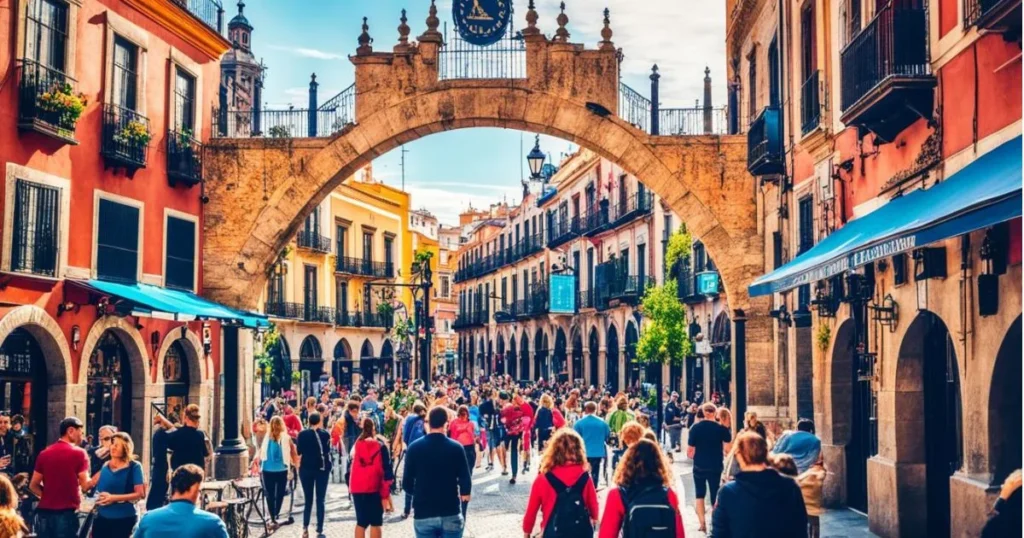
Whether you’re a history fan or a food lover, a visit to La Latina will surely leave you enthralled. This charming neighborhood will beguile you with its traditional and contemporary Spanish scenes, from enchanting historical sites to hip bars and restaurants. La Latina is a must-visit neighborhood in Madrid where one can get a real taste of the authentic Spanish lifestyle.
To sum it up, exploring La Latina offers a perfect mix of culture, history, and gastronomy, all whilst immersing yourself in the joyous spirit of Madrid.
Malasaña: Madrid’s Hipster Heartland
If you’re looking for a taste of Madrid’s alternative and bohemian scene, Malasaña is the neighborhood for you. Known for its indie music venues, vintage boutiques, and vibrant street art, Malasaña oozes creativity and hipster charm. As you explore its streets, you’ll discover a treasure trove of unique shops, quirky cafes, and hidden courtyards.
One of the highlights of Malasaña is the Plaza del Dos de Mayo, a bustling square that serves as the heart of the neighborhood. Here, you can mingle with locals, relax in one of the outdoor terraces, and soak in the lively atmosphere. The square is also a hotspot for cultural events and live performances, so be sure to check the schedule for any upcoming shows.
Another must-see in Malasaña is the Mercado de San Ildefonso, a multi-story market that showcases the best of Madrid’s gastronomy. From delicious tapas and fresh seafood to local cheeses and wines, it’s a paradise for food lovers.
Street art lovers are in for a treat in Malasaña. Everywhere you look, you’ll see colorful murals and graffiti, most notably on the walls of the Tabacalera Promoción del Arte, a former tobacco factory turned cultural center.
And for those interested in vintage shopping, there’s no better place than Malasaña. The neighborhood is known for its various vintage and second-hand shops like Magpie Vintage and La Mona Checa, where you can find everything from clothes and accessories to furniture and home goods.

After a day of exploring, why not catch a show at the Teatro Lara, one of Madrid’s oldest and most beloved theaters, or enjoy a drink at one of the cool, trendy bars like Tupperware or Kikekeller, which not only serves cocktails but also doubles as a design shop.
Malasaña also boasts some of the best nightlife in Madrid. From chilled-out bars to lively nightclubs, there’s something for everyone in this vibrant neighborhood. If you’re a music lover, you’re bound to love venues like Ochoymedio and Sala El Sol, known for their live music and eclectic DJ sets.
All in all, Malasaña is a true gem for those looking to experience a different side of Madrid. With its unique blend of history, culture, creativity, and youthful energy, this neighborhood is sure to leave a lasting impression.
A Taste of Madrid: Food Scene and Culinary Delights
Madrid is a paradise for food lovers, offering a wide range of culinary delights. From traditional Spanish dishes like paella and tapas to innovative fusion cuisine, Madrid’s food scene is sure to satisfy all taste buds. Whether you’re a fan of seafood, meat, or vegetarian options, you’ll find a plethora of delicious choices in the city.
Exploring the culinary scene of Madrid is like embarking on a gastronomic adventure. You can start your day with a traditional Spanish breakfast of churros con chocolate at one of the city’s charming cafés. As the day progresses, indulge in a variety of tapas, and small plates of delectable bites that showcase the vibrant flavors of Spanish cuisine. Whether you prefer classics like patatas bravas and jamón ibérico or more innovative creations, Madrid has it all.
For a taste of traditional Spanish cuisine, head to the historic Mercado de San Miguel, a food market where you can sample a diverse range of dishes and delicacies. From fresh seafood to artisanal cheeses and local wines, this market is a food lover’s paradise. Immerse yourself in the bustling atmosphere and savor the flavors of Madrid.
| Iconic Dishes to Try | Best Places to Eat |
|---|---|
|
|

Don’t forget to indulge in Madrid’s famous desserts, such as the creamy flan and the sweet almond-based turrón. Pair your meals with local wines from the nearby regions of Ribera del Duero or Rioja for a complete sensory experience.
Whether you choose to dine in a traditional tavern, a modern restaurant, or a trendy gastro-market, Madrid’s culinary scene will leave you craving for more. So, venture out and explore the diverse flavors of this dynamic city – you won’t be disappointed!
Madrid After Dark: A Guide to Nightlife and Entertainment
Experience the vibrant nightlife of Madrid Spain and immerse yourself in the city’s energetic entertainment scene. From passionate Flamenco shows to the ultimate night out in Chueca, Madrid offers a variety of after-dark activities that will make your visit unforgettable.
Flamenco Shows: The Passionate Pulse of Madrid
When in Madrid, don’t miss the opportunity to witness the thrilling art form of Flamenco. As an integral part of Spanish culture, Flamenco showcases powerful dances, soulful music, and intricate guitar playing. Immerse yourself in the passionate pulse of Madrid as talented performers bring this traditional art form to life.
Experience the captivating Flamenco shows at renowned venues like Cardamomo or Casa Patas, where talented artists captivate audiences with their fiery moves and heartfelt performances. Whether you’re a seasoned fan or new to Flamenco, the shows in Madrid will leave you mesmerized and full of admiration for this passionate art form.
For the uninitiated, Flamenco is not simply dancing and music but a passionate and expressive performance art that tells a powerful story. Starting in the late 18th century amongst the Gypsy populations of Andalusia, Flamenco is now globally recognized and holds a deep-seated place in Spanish culture.

A Flamenco performance typically features three aspects: cante (singing), baile (dancing), and toque (guitar playing). The cante is filled with raw emotion and reflects themes of love, despair, and struggle, all bathed in the echo of soulful strains. The dancers amplify the emotion through their expressive movements and rhythmic stomping. Coupled with passionate guitar playing, Flamenco can be a deeply moving experience for audience members.
In Madrid, you have a myriad of venues to choose from, each with its unique atmosphere and charm. Cardamomo is renowned for its intimate ambiance and features some of the top performers in the industry, making it a Madrid hotspot for flamenco fans. Casa Patas, on the other hand, offers a more traditional setting, famed for its authenticity and respect for the timeless tradition of Flamenco.
To make the experience even more memorable, many of the Flamenco venues in Madrid offer dinner shows where attendees can enjoy typical Spanish or Andalusian cuisine as they watch the performance. Feast on delectable dishes like paella and tapas, paired with Spanish wines or Sangria, as you soak in the exhilarating performance.
Remember, Flamenco is a living art, constantly evolving and adapting. Each performance is unique and ephemeral, existing only in the moment it is performed. So be sure to catch a Flamenco show while you’re in Madrid – it’s an experience like no other. Immerse yourself and feel the intensity, soul, and passion that are synonymous with Flamenco; you’re sure to be entranced.
Chueca: The Ultimate Night Out
If you’re looking for a vibrant night out in Madrid, head to Chueca, the city’s LGBTQ+ neighborhood. Known for its lively atmosphere and inclusive spirit, Chueca offers a diverse range of entertainment options that cater to every taste.
Start your night with a stroll through the colorful streets of Chueca, lined with trendy bars, lively clubs, and fashionable shops. Grab a refreshing drink at one of the local bars and enjoy the bustling energy of the neighborhood. As the night progresses, explore the diverse nightlife venues Chueca has to offer, from drag shows to dance clubs.
Share a dance with locals at the gay club Delirio or sway to the music at Club 33. Then, walk around Plaza Pedro Zerolo, a tribute to a local activist for LGBTQ+ rights.
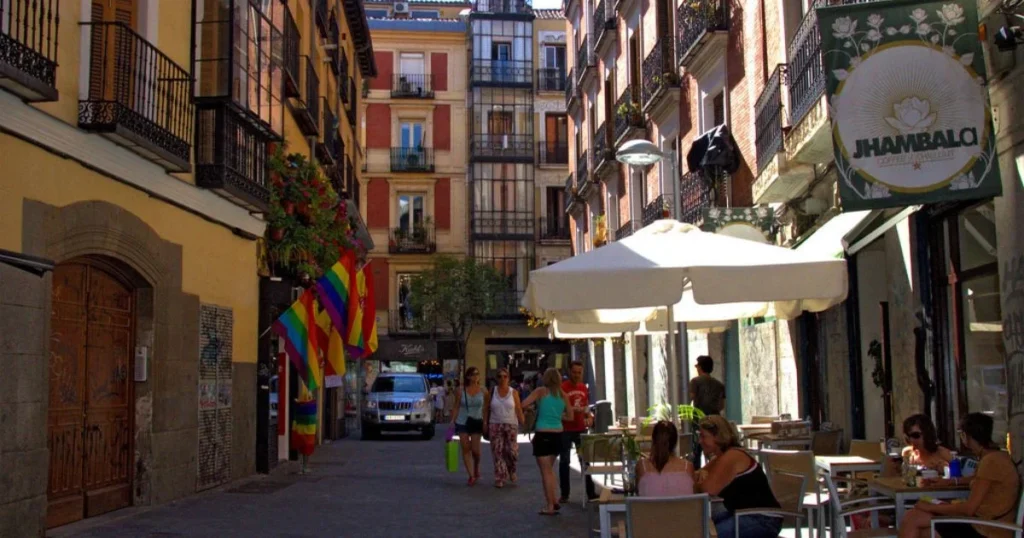
Food lovers can also explore diverse restaurants and cafes around, offering everything from traditional Spanish cuisine to modern fusion dishes. Start at the Mercado de San Antón for a gastronomic experience, sampling bites from numerous vendors.
If live music is your scene, then head to the Fulanita de Tal, a one-of-a-kind venue known for its live entertainment and open mic nights. Art enthusiasts can take a quick detour to the Calle de Fuencarral, home to a beautiful assortment of art galleries and boutiques.
Take one night in Chueca, and you’ll understand why it’s considered a beacon of diversity and acceptance. From the welcoming locals to the lively nightlife, it’s a hub of energy and color that is not to be missed in your Madrid experience.
Remember, Madrid, much like Chueca, stays awake late. So, feel free to roam and revel till the early hours of the morning, basking in the vibrant culture and diversity of the neighborhood.
| Venue | Description |
|---|---|
| Escape Room Live | Experience an interactive adventure with friends and solve challenging puzzles in themed escape rooms. |
| Bar El Tigre | Enjoy delicious tapas and refreshing drinks served generously at affordable prices that bring locals and visitors together. |
| LL Show Bar | Be entertained by fabulous drag performers who bring glamour, humor, and spectacular shows to the stage. |
| Teatro Barcelo | Dance the night away at one of Madrid’s top nightclubs, featuring renowned DJs and a stylish ambiance. |
Chueca comes alive after dark, offering a lively and welcoming environment for everyone to enjoy. Whether you’re celebrating with friends, seeking an unforgettable night out, or immersing yourself in Madrid’s LGBTQ+ culture, Chueca is the place to be.
Parks and Recreation: Madrid’s Green Oases
When visiting Madrid, take a break from the bustling city streets and immerse yourself in the tranquil beauty of its parks. Madrid is home to several green oases that provide a welcome respite from the urban environment. Two of the most notable parks in Madrid are El Retiro Park and Casa de Campo, each offering a unique recreational experience.
In addition to these parks, don’t miss out on Madrid’s other parks that offer beauty and relaxation such as Madrid Rio, Quinta de los Molinos, and El Capricho Park. Whether you enjoy quiet strolls, picnics, art, or outdoor activities, Madrid’s parks have a lot to offer.
Remember, these tranquil retreats are not only there to be admired, but also respected. As you enjoy these green spaces, be sure to help preserve them for locals and future visitors alike while enjoying the nature and culture of Madrid.
El Retiro Park: A Haven in the City
El Retiro Park is a true sanctuary in the heart of Madrid, offering a serene escape from the busy city streets. As you enter the park’s lush gardens, you’ll be greeted by towering trees, vibrant flowers, and beautifully manicured landscapes. Stroll along its paths, rent a rowboat on the tranquil lake, or simply find a quiet spot to relax and unwind.
One of the park’s iconic attractions is the Crystal Palace, a stunning glass and metal structure that houses temporary art exhibitions. Inside, you can admire contemporary artworks while enjoying the natural surroundings. Another must-visit spot is the Rosaleda, a rose garden bursting with fragrant blooms in a variety of colors.
El Retiro Park also features impressive monuments, including the famed Fountain of the Fallen Angel and the Monument to Alfonso XII. These landmarks add a touch of history and grandeur to the park’s peaceful ambiance.

Casa de Campo: Madrid’s Largest Park
For those seeking a more active outdoor experience, Casa de Campo is the perfect destination. Located on the outskirts of Madrid, this sprawling park offers vast green spaces, recreational facilities, and breathtaking views of the city.
Casa de Campo is a paradise for nature enthusiasts and sports enthusiasts alike. Explore its extensive network of trails, perfect for hiking, biking, or jogging. Enjoy a picnic by one of the park’s many lakes, or challenge yourself to a round of golf at the Campo de Golf de la Ciudad.
If you’re traveling with children, they’ll love the park’s attractions such as the Madrid Zoo and the Amusement Park, where they can interact with animals and enjoy thrilling rides.
Casa de Campo also boasts a cable car that offers a bird’s-eye view of the park and the city. Take a leisurely ride and admire the stunning panoramic vistas. And when hunger strikes, head to one of the park’s charming restaurants to savor traditional Spanish cuisine amidst the tranquil surroundings.
Whether you choose to explore the peaceful elegance of El Retiro Park or seek adventure in the expansive Casa de Campo, Madrid’s parks offer a delightful escape for travelers of all interests. These green oases provide a unique perspective, showcasing the city’s commitment to preserving natural spaces amidst the urban landscape.
Shopping in Madrid: From Boutique Finds to Market Wonders
Madrid is a shopping paradise, offering a delightful blend of high-end boutiques, trendy shops, and bustling markets. Whether you’re a fashion enthusiast, a souvenir collector, or an art lover looking for unique crafts, Madrid has something to suit your taste.
This section will take you on a journey through the city’s top shopping destinations, from renowned shopping streets to hidden gems. Take a stroll through the vibrant markets of Madrid and discover a world of treasures.
When it comes to boutique finds, Madrid boasts an array of exclusive luxury brands and designer labels. Explore the trendy neighborhood of Salamanca, where you’ll find renowned fashion houses such as Loewe and Carolina Herrera. If you’re looking for a curated selection of contemporary fashion, head to the trendy district of Malasaña, known for its independent boutiques and emerging designers.
For a truly unique shopping experience, make your way to Madrid’s bustling markets. The Mercado de San Miguel is a must-visit for food lovers, offering a variety of fresh produce, artisanal products, and delectable tapas.
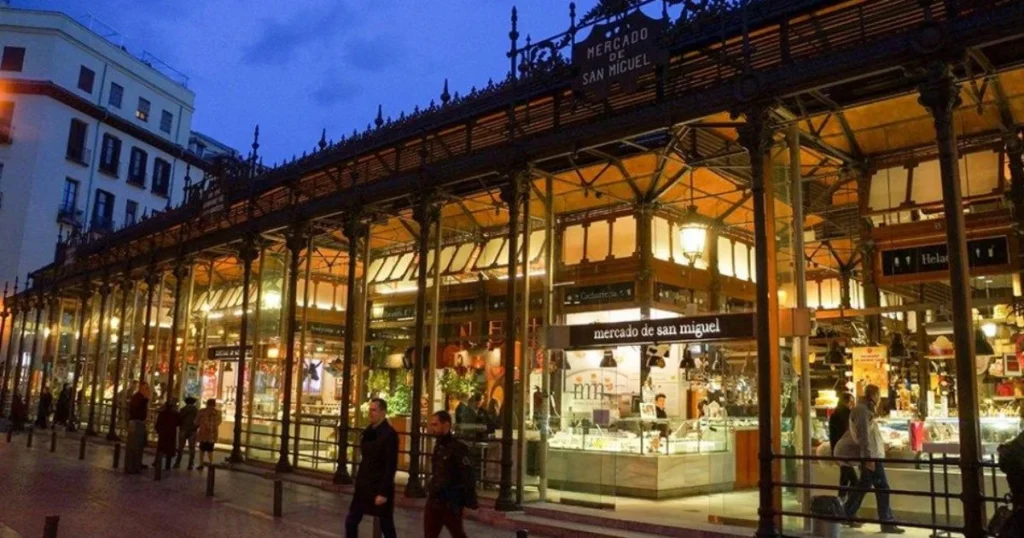
If you’re in search of vintage treasures and antiques, The El Rastro flea market is the place to be. Every Sunday, this sprawling market comes alive with a vibrant mix of souvenirs, clothing, and curiosities.
| Shopping Destination | Description |
|---|---|
| Gran Via | Madrid’s most famous shopping street is lined with department stores, international brands, and iconic landmarks. |
| Mercado de San Miguel | A vibrant food market offering a wide range of gastronomic delights, including fresh produce, tapas, and local specialties. |
| El Rastro | The largest flea market in Madrid, offering an eclectic mix of vintage clothing, antiques, and unique finds. |
| Calle Serrano | A luxury shopping street in the upscale neighborhood of Salamanca, famous for its designer boutiques and high-end fashion brands. |
| Malasaña | A hip and vibrant neighborhood with a thriving independent fashion scene and eclectic shops. |
Whether you’re seeking high-fashion couture, one-of-a-kind treasures, or a taste of local cuisine, shopping in Madrid is a truly captivating experience. So grab your wallet and get ready to indulge in the vibrant retail scene of this dynamic city!
Day Trips from Madrid: Around the City’s Edge
While Madrid offers a wealth of attractions and experiences, venturing beyond the city limits allows you to discover even more of Spain’s rich history and culture. Take a break from the bustling capital and embark on unforgettable day trips to explore the surrounding areas.
Toledo: A Historic Day Out
Just about an hour’s drive from Madrid, the city of Toledo is known as the “city of three cultures” due to the Christian, Jewish, and Muslim influences that can be seen in its architecture and culture. Step back in time as you walk along the cobblestone streets lined with medieval buildings. Be sure not to miss exploring the stunning Toledo Cathedral and the Alcazar fortress.
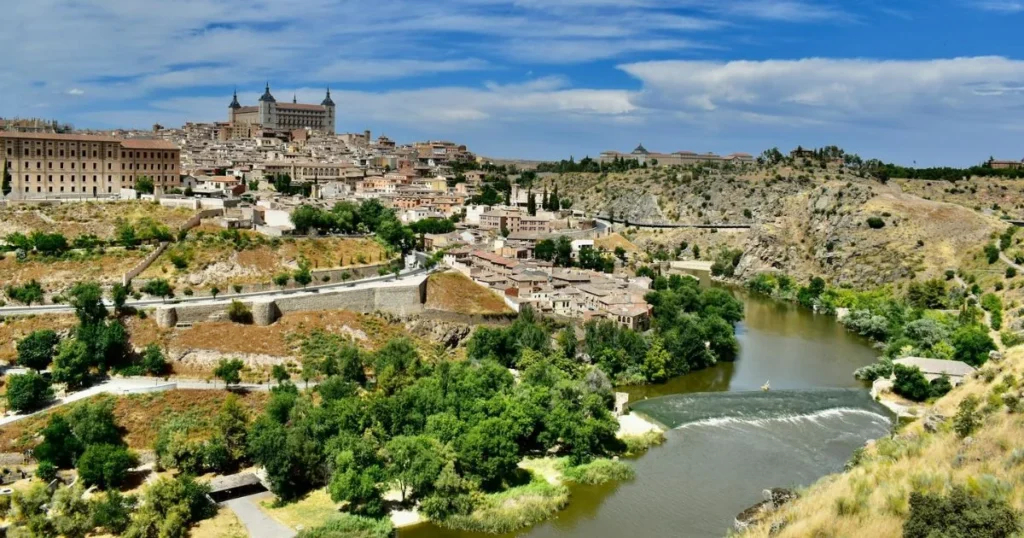
The Toledo Cathedral, which took more than 200 years to complete, is a magnificent example of Gothic architecture, with its elaborate altar, beautiful chapels, and treasured works of art, including masterpieces by El Greco. While visiting this grand religious edifice, you can also explore the Cathedral Museum, which houses an impressive collection of sacred art and vestments.
The Alcazar fortress, which sits high above the city, offers breathtaking panoramic views of Toledo. Its architecture is a blend of various styles, from the original Moorish fortress to the later Christian castle and modern renovations. Inside, you’ll find the Army Museum, which hosts an extensive collection of military artifacts and showcases Spain’s military history, from ancient times up to the present.
As you stroll through the old town, you’ll see a blend of architectural styles, from Moorish to Gothic, reflecting the city’s diverse cultural heritage. Don’t forget to visit the historic Jewish Quarter, with its narrow streets, ancient synagogues, and well-preserved buildings providing a glimpse into a time long past.
Many traditional crafts can be found here such as Damascene work, a technique involving inlaying gold or silver into steel to create intricate designs, and marzipan sweets handmade following centuries-old recipes.
The city is also renowned for its culinary delights. Indulge in local specialties such as game meats, Manchego cheese, and local wines. To make your visit even more memorable, consider hiring a local guide to learn more about the rich history of this city of the three cultures and its equally complex and striking cuisine.
Remember to wear comfortable shoes – Toledo’s enchantingly narrow streets and hills can be steep! But the spectacular views over the River Tagus, the charm of the old town, and the city’s rich history make the visit truly worthwhile.
Segovia: Aqueducts and Alcazars
Famed for its spectacular Roman aqueduct, Segovia is another stunning city that’s easily accessible for a day trip from Madrid. Apart from the Aqueduct, visit the Segovia Cathedral and the Alcazar of Segovia with beautiful views of the surrounding city. One of the city’s most outstanding features is the Roman aqueduct.
This breathtakingly well-preserved piece of Roman engineering spans 818 meters and looms over the city’s quaint streets at its maximum height of 29 meters in the air. It’s estimated that this aqueduct was built around the 1st century AD to bring water from the Frio River to the city – a distance of nearly 17 km.
After you’ve marveled at the aqueduct, take a stroll to the Segovia Cathedral. This Gothic-style cathedral, which was completed in the late 16th century, is known as “The Lady of Cathedrals” and reigns as the last Gothic cathedral built in Spain. Its three main gates, the Pardon Gate, the San Frutos Gate, and the San Geroteo Gate, each exhibit stunning detail, and its cloister is one of the most beautiful in Spain.
When you’re finished exploring the cathedral, make your way to the Alcazar of Segovia. This fairy-tale castle, with its pointed towers and turreted walls, was originally built as a fortress but has served as a royal palace, a state prison, a Royal Artillery College, and a military academy since.

While walking through the Alcazar’s rooms, you will find yourself surrounded by beautiful Mudejar ceilings, colorful stained glass windows, and intricate tilework. Walk up to the Tower of Juan II for incredible views of the city and the rest of the castle.
Segovia is also famous for its local gastronomy, most notably the “cochinillo” or roast suckling pig. Paired with a glass of red wine, this dish is a must-try for any foodie.
Overall, a trip to Segovia offers a perfect combination of stunning Roman and medieval architecture, rich history, and delightful gastronomy.
Avila: Medieval Walls
Known for its well-preserved medieval walls, Avila offers history lovers a feast for the eyes. Let your imagination run wild as you walk along these walls which offer panoramic views of the city and its surrounding countryside. Visit the Cathedral of Avila, the Basilica de San Vicente, and if time allows, the mystic Saint Teresa’s Convent.

The Cathedral of Avila, also known as Catedral del Salvador de Avila, is notable for its impressive Gothic and Romanesque architecture. Considered one of the first Gothic cathedrals in Spain, it was built in the 12th century and serves as a fortress alongside the city walls. Don’t miss the opportunity to admire the fine details of the alabaster altarpiece and the beautiful cloister.
The Basilica de San Vicente is another significant religious site in Avila. It is the second most important church after the cathedral and it is known for its remarkable Romanesque architecture. The Basilica also houses the tomb of the Christian martyrs Vincent, Sabina, and Cristeta.
If you’re interested in Spanish mysticism, be sure to stop by the Convent of Saint Teresa. It is named after Saint Teresa of Avila, one of the most revered figures of the Catholic Church who was born in this city in 1515. The convent was built on the site of her birthplace and it showcases a collection of her relics, including her ring and rosary.
The city of Avila, named a UNESCO World Heritage site in 1985, boasts many other attractions, all enveloped within its impressive walls. These include the Plaza Mayor, with its lively atmosphere and charming cafes, and the Murallas de Avila, where you can climb to the top and enjoy a bird’s-eye view of the city below.
Lastly, Avila is famous for its regional cuisine. Don’t miss the chance to try the renowned ‘Yemas de Santa Teresa’, a sweet made from egg yolks named after the city’s patron saint. Also, enjoy some ‘Chuleton de Avila’, a prime cut of beef that is a highlight of the local gastronomy.
With beautiful architecture, rich history, and delectable culinary specialties, Avila promises a journey back in time and a feast for all senses.
Salamanca: Architectural Treasures
A UNESCO World Heritage site, Salamanca is renowned for its university, which is the oldest in Spain and one of the oldest in Europe. Wander through the charming old town, visit the university grounds, and make sure to check out the beautiful Plaza Mayor.
Salamanca’s architectural treasures do not end there. Venture to the city’s two cathedrals, the Old Cathedral (Catedral Vieja) and the New Cathedral (Catedral Nueva), both of which exude grandeur and history. The Old Cathedral, constructed during the 12th and 13th centuries, showcases the Romanesque style, while the New Cathedral, built between the 16th and 18th centuries, displays Gothic and Baroque influences.
Don’t forget to take a close look at the New Cathedral’s facade, where amid its intricate carvings, you’ll find some surprising elements like an astronaut and a gargoyle eating ice cream.
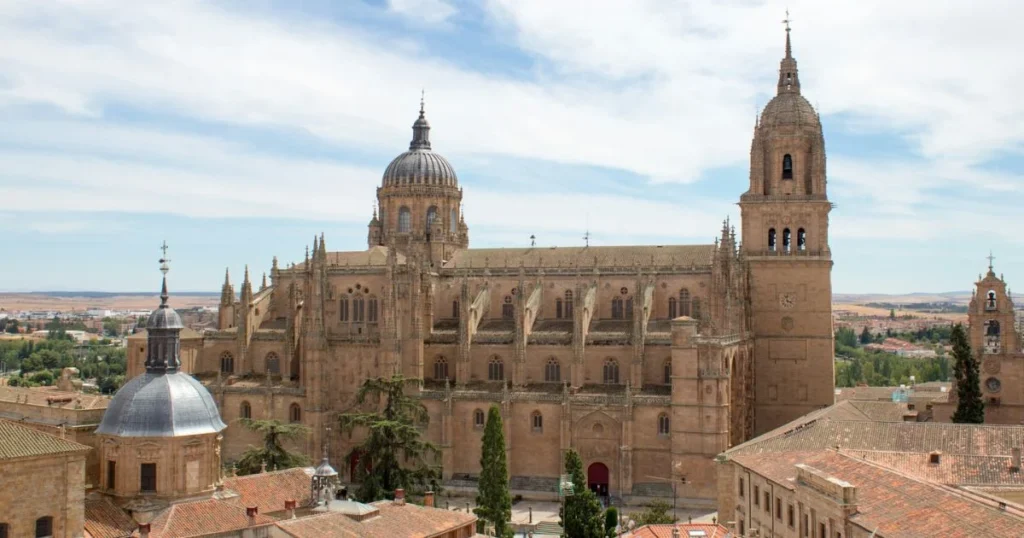
You must also visit the University of Salamanca, a masterpiece of Plateresque style. Founded in 1218, it housed famous students like Christopher Columbus and Miguel de Cervantes. Make sure to spot the famous frog, a small carving on the facade of the university’s entrance. It’s said that students who find the frog among the detailed carvings are destined for academic success.
For a taste of Salamanca’s vibrant culture, spend some time at Plaza Mayor, the heart of the city. Regarded as one of the most beautiful squares in Spain, it is surrounded by baroque buildings housing cafes, shops, and the City Hall. By day, it’s bustling with locals and tourists; by night, it transforms into a magical spot with its illuminated sandstone buildings.
Finally, don’t miss the Casa de las Conchas (House of Shells), a distinctive building covered in more than 300 scallop shell decorations, the symbol of the Order of Santiago. Today, it houses the city’s public library and a tourist information center.
Filled with stunning sights and rich history, it’s easy to see why Salamanca is hailed as a UNESCO World Heritage site. A visit here promises a journey through time as you immerse yourself in the Spanish golden age of education and architecture.
Guadarrama National Park: A Must For Nature Lovers
If you’re more of a nature lover than a history buff, head to the Sierra de Guadarrama National Park. It’s abundant in wildlife, hiking routes, and stunning views. From relaxing walks to more strenuous hikes, this destination suits all types of outdoor enthusiasts.
This national park stretches across the provinces of Madrid and Segovia and is home to goats, foxes, and a variety of bird species. It has diverse flora as well, with pine, chestnut, and oak forests spread throughout its expanse, making it an ideal spot for wildlife enthusiasts.

One of the park’s most popular hikes is to the Peak of Peñalara, standing at 2,428 meters high. This is the highest peak in the Sierra de Guadarrama mountain range and offers an extraordinary panorama from its summit. You can take the normal route that starts in Puerto de Cotos which is an easy and direct ascent, or opt for the path via the Laguna Grande de Peñalara if you are in for more of a challenge.
You can also visit the Valley of La Fuenfría, famous for its well-preserved Roman road. The valley offers three different hiking routes allowing you to enjoy its stunning landscapes at your own pace.
Alternatively, walk through the pastures of the Sierra de Malagón to enjoy the peaceful countryside atmosphere. Keep an eye out for the different species of birds that nest in this area. Thrill-seekers can opt for more adventurous activities such as rock climbing, mountain biking, zip-lining, horseback riding, and even skiing in the winter.
In your downtime, you can enjoy local delicacies, which include Segovian suckling pig and Madrid’s stew, at one of the many restaurants sprinkled across the nearby townships. Whether you are an avid walker, a wildlife observer, or just someone who breathes fresh air, Sierra de Guadarrama National Park is the perfect place to immerse yourself in Spain’s splendid natural beauty.
El Escorial: Known For The Royal Palace
A short train ride away from Madrid, the town of El Escorial is known for the Royal Palace, a 16th-century architectural masterpiece that boasts an impressive library, as well as the Pantheon of Kings, where Spanish monarchs are buried.

Named after Cosimo I de’ Medici, Grand Duke of Tuscany who commissioned its construction, the Royal Palace, also known as Monastery of San Lorenzo El Escorial, represents one of the Spanish Renaissance’s finest monuments. King Philip II of Spain commissioned the project in honor of Saint Lawrence, marking the battle victory over France on the Saint’s feast day.
The palace, which took 21 years to complete, is divided into multiple attractive sections. The highlight for many visitors is the palace’s library, which contains over 40,000 volumes. The library’s vaulted ceilings, ornamented with frescoes depicting the seven liberal arts, are a sight to behold. The Royal Palace also houses an impressive collection of art, including works by El Greco, Velázquez, and Titian.
Another significant attraction within the Royal Palace is the Pantheon of Kings. Built-in Baroque style, the pantheon holds the remains of over 30 Spanish monarchs. The burial chamber is beautifully adorned with gold leaf and marble. Despite its proximity to Madrid, El Escorial offers a tranquil respite from the bustling city life.
Visitors to the town can also enjoy relaxing walks through the serene gardens, expansive plazas, and quiet streets lined with cafés and shops. Whether you’re a history enthusiast or just looking for a day out, El Escorial provides an enriching and engaging exploration.
Aranjuez: Known For Its Rich Gastronomical Culture
Visit the Royal Palace of Aranjuez, a summer palace of the Spanish monarchs, surrounded by lavish gardens. Cruz and take a boat ride on the amazing Tagus River and sample the local gastronomy that this town is known for.
These day trips can offer a sense of Spain’s diversity, history, and stunning beauty that extends far beyond Madrid’s city limits. Depart from Madrid in the morning and drive through the scenic Spanish countryside to reach the first destination: The Royal Palace of Aranjuez.
This royal residence was once the summer palace for Spanish monarchs and features exquisite gardens that were designed to create a heavenly atmosphere on Earth. The palace’s elaborate design, which includes the Porcelain Room and Throne Room of Elizabeth II, is sure to leave you awestruck.
Next, enjoy a boat ride on the Tagus River, the longest river on the Iberian Peninsula. The river flows through the picturesque landscapes of Spain, and Portugal, and also crosses the Spanish-Portuguese border. The boat ride provides an opportunity to witness nature’s beauty from a unique perspective.
The town of Aranjuez is known for its rich gastronomical culture. At a local restaurant, sample some of the town’s specialties, which include local wines and gourmet dishes prepared with ingredients grown in the fertile Tagus River valley. Cafes serving traditional pastries and a variety of tapas are also prevalent, providing a chance to savor the delights of Spanish cuisine.
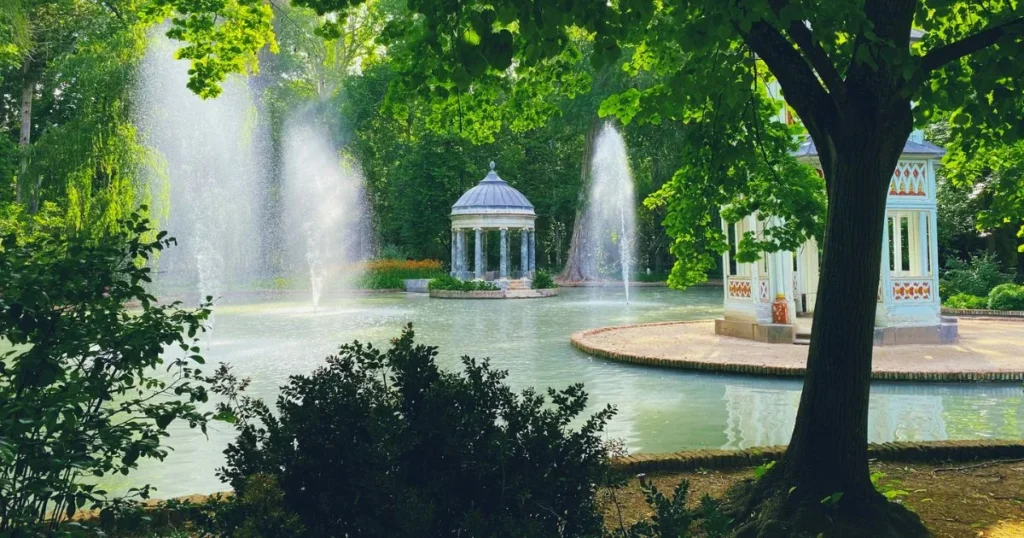
After a fulfilling day, return to Madrid with a full stomach and memories of once-in-a-lifetime experiences. This immersive day trip offers an unforgettable journey into Spain’s stately past, its vibrant culture, and stunning natural landscapes.
So, be ready to soak up some Spanish culture, enjoy the scenic beauty, and savor the unique gastronomies that this region has to offer. It’s a perfect getaway not too far from Madrid’s city life. This diverse experience will make you appreciate the Spanish lifestyle and history even more.
Conclusion
In conclusion, by maximizing your Madrid experience, you can ensure that your trip to this vibrant city is nothing short of unforgettable. To make the most of your visit, it is important to manage your time effectively and prioritize the attractions and activities that interest you the most. Additionally, familiarize yourself with the local cultural etiquette to fully immerse yourself in the Madrid way of life.
Throughout your journey in Madrid, you will discover why this city captures the hearts of travelers. From the rich cultural heritage to the lively neighborhoods, Madrid offers a magnetic charm that lingers even after you’ve left. The vibrant energy, delicious cuisine, world-class museums, and friendly locals are just a few of the reasons why you’ll long to return to Madrid.
So pack your bags, book your tickets, and get ready to embark on an incredible adventure in Madrid. Whether you’re exploring the historical landmarks, indulging in the local cuisine, or simply strolling through the charming streets, Madrid has something to offer everyone. Get ready for a seamless and unforgettable trip that will leave you longing to return to this captivating city.
FAQ
Q: What are the Madrid top 10 attractions I should add to my trip plan?
A: The city of Madrid offers plenty of fascinating attractions. Your list could include, the Royal Palace, the Prado Museum, Retiro Park, Madrid Barajas Airport, Barrio De Las Letras, Puerta Del Sol, and the official Real Madrid’s Stadium. Madrid has many other attractions, a detailed list can be found on the official tourism website.
Q: How do I plan my trip to Madrid in 2024?
A: Planning a trip to Madrid can be an exciting experience! You can start by deciding on the dates and booking your flights to Madrid Barajas Airport in advance. Next, explore the official tourism website which gives a good overview of things to do in Madrid. You can also get a map of Madrid to help you in your planning. Don’t forget to include some of the European cities like Barcelona, Seville, and Valencia in your trip if time permits. They are easily reachable from the city center.
Q: Are there any official tourism products that can help me explore Madrid?
A: Yes, there are numerous official tourism products available to make your Madrid travel experience hassle-free. They offer many facilities and services. You can find more information about these on the official tourism website of Madrid.
Q: How can I explore the century-old Barrio De Las Letras?
A: Barrio De Las Letras is a part of the city that is rich in tradition and history. You can explore this neighborhood on foot. It’s known for its literary history and labyrinthine streets lined with bars, restaurants, and artisanal shops. A guided tour can help you understand the cultural life and history of this place in Madrid.
Q: How can I enjoy both the day and nightlife in Madrid?
A: Madrid is known for its vibrant day and nightlife. You can start your day with a visit to the Prado Museum or a walk along the Paseo Del Prado. Evenings can be enjoyed with tapas at bars in the barrio and flamenco shows. The city center is bustling with activities until the early morning hours.
Q: What is special about Madrid on the Iberian Peninsula?
A: Madrid lies at the heart of the Iberian Peninsula. As one of Europe’s largest and one of the world’s most vibrant cities, Madrid is known for its rich cultural heritage, bustling lifestyle, mouthwatering cuisine, and renowned football club, Real Madrid. The city offers a blend of historic charm and modern ambiance that makes it stand out among European cities.
Q: How do I get around Madrid while visiting the city?
A: Madrid has a very efficient public transport network. Metro, bus, and taxi services are widely available. You can also use a bike or simply walk to explore the city, especially the city center. The official tourism website provides a detailed map of Madrid’s public transportation system.
Q: Where can I exchange my currency in Madrid?
A: You can exchange your currency into Euro at Madrid Barajas Airport, local banks, or at foreign exchange bureaus around Madrid. It’s always a good idea to compare rates before making an exchange as rates can vary.
Q: How can I explore Madrid’s cultural life?
A: Madrid is renowned for its rich cultural life. You can explore it by visiting museums, and art galleries, or attending local festivals or live performances. A walk around the Barrio De Las Letras, or a visit to the Prado Museum can also give you a glimpse of Madrid’s cultural heritage.
Q: What are some things to do in Madrid that don’t involve spending a lot of money?
A: There are numerous things to do in Madrid that don’t require a large budget. Walking tours around Madrid, particularly in areas such as Barrio De Las Letras, are free. Many museums including the Prado Museum offer discounted or free entry on certain days and times. The city parks are also free and provide a wonderful place to picnic and relax.



